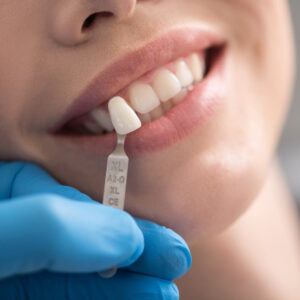
Try as we might, damage and decay can still happen to our teeth—sometimes seriously! Advanced damage or decay can even result in missing teeth if untreated, which can come with a whole host of other problems for your oral and overall health. That’s where a dental crown procedure comes in! Crowns are safe, effective tools for saving teeth that have been badly damaged, and the end result looks and feels as though nothing was ever wrong to begin with, making them an indispensable part of family dental care. If you’ve been told you need a crown, here’s what you can expect including the steps of the procedure itself to aftercare tips.
What Are Crowns for Teeth?
Crowns for teeth are sometimes called dental “caps,” and they are essentially manufactured teeth that are made to sit on your own natural teeth that have been damaged due to injury or decay. Crowns can be made out of many different materials such as porcelain, gold, various metal alloys, acrylic, and ceramics. They are modeled into the shape of your own natural teeth and artificially colored to match the shade of the rest of your smile—however, this is only possible with certain materials. Crowns for teeth are as strong as your natural teeth and protect the tooth they sit on while allowing you to speak, bite, and chew normally, and in many cases can prevent the need for major restorative dental procedures later on.
What Are the Dental Crown Procedure Steps?
It might take a few visits to your dentist to complete all of the steps in a dental crown procedure. Typically, a patient will need X-rays to examine the extent of the damage beforehand. Sometimes a tooth will be too damaged to physically support a crown, in which case other treatments like a root canal might be necessary first. Once your dentist has established that you are a good candidate for a tooth crown procedure, they can begin with the actual process.
1. Making an Impression
Your dentist will use a local anesthetic to completely numb the gums and tissue around the tooth so you won’t feel a thing except for maybe some pressure while they work. In order for the crown to fit well, the affected tooth needs to be filed down, which your dentist will do with a dental drill.
2. Laboratory Work
With the tooth prepared and a recording of the exact shade of your tooth taken at the same time, a lab will construct the crown out of your desired material and match it to the correct color.
At Champagne Family Dentistry we offer same-day CEREC crowns for the majority of our patients. This is done with a digital scan, and we mill these in the office for same-day delivery, which means we can skip an impression and a lab work and save your time!
3. Cementing the Permanent Crown
Once your dentist is satisfied with the fit and placement of the crown, they will use ultra-strong dental cement to permanently secure the crown in place. It will take a few minutes for the cement to dry in place, and around 24 hours for it to cure completely, so it’s crucial that you don’t do anything that might dislodge or loosen the crown during this time. If the crown becomes loose, call your dentist to have it refitted right away.
How Long Do Dental Crowns Last?
Congratulations! You’re dental crown procedure is now complete, and you can enjoy the natural-looking final product for an average of 15 years before it may need to be replaced due to degradation. However, properly maintained and cared-for crowns have almost been known to last for as long as 25-30 years, so the real answer to how long a crown lasts depends on how well you maintain them.
Does a Crowned Tooth Require Any Special Care?
Crowns for teeth require certain care protocols that your dentist will explain before and after your procedure. It’s important that you don’t eat anything crunchy or hard for the first 24-36 hours after your crown has been placed so the dental dement has time to fully harden. You should also avoid excessively hot or cold drinks during this time, and definitely refrain from smoking. Smoking dries out the mouth inhibiting healing and potentially exposing the operation site to harmful bacteria.
After this initial period, you can go back to eating, drinking, and caring for your teeth as you normally would. However, it’s still a good idea to be conscious of your crown in your daily life and avoid too many hard or crunchy foods—especially if your crown covers one of your front teeth, which can be more fragile and susceptible to fracture. It’s natural to experience some sensitivity and discomfort for the first few hours and days after your dental crown procedure, which can be treated with a cold compress and over-the-counter pain medication if necessary. However, if you are experiencing persistent or extreme tooth pain after crown placement, make an appointment with your dentist for a follow-up appointment as you may be experiencing reinfection of the tooth or a traumatized nerve—both of which will require additional treatment.
If you are looking for restorative dentistry in Sparks, Nevada, like a dental crown procedure, filling, or dental implant contact Champagne Family Dentistry today. With over 40 years of experience helping our patients regain their smiles, we’ll be happy to answer any questions you have about crowns for teeth, insurance, or anything else. Call Champagne Dentistry in Sparks and book your first appointment!

